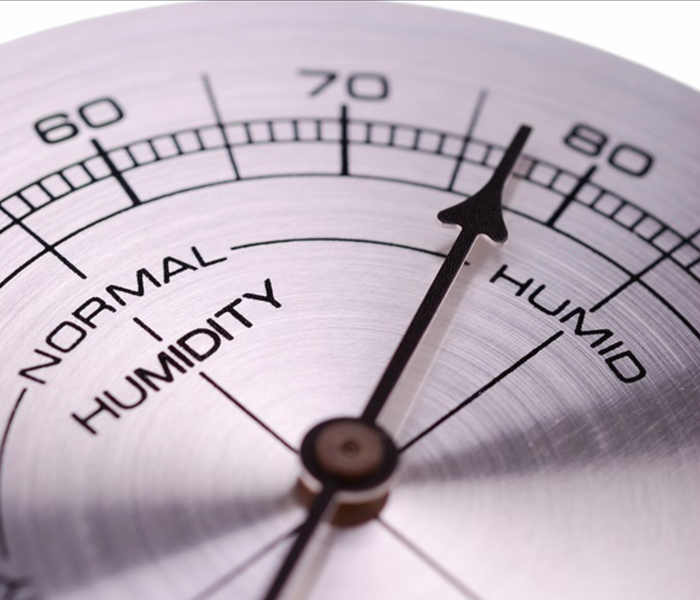Humidity, Mold and Air Quality in Your Eastern NC Home
6/1/2018 (Permalink)
We here at SERVPRO of Lenoir, Duplin & Jones Counties want the people of Eastern NC to understand the high humidity issues we all deal with every summer as it relates to our homes.
Air barriers help to control the airflow through and within an enclosed structure. By controlling airflow, moisture is also controlled and therefore lessening the threat of mold in your home.
If moist indoor air comes into contact with a cold surface, it can result in condensation. An air barrier prevents cooler surfaces from being connected with indoor humid air. Warm air can store a lot of moisture, wile cold air stores very little moisture.
When the amount of moisture that can be stored in the air changes from warm to cool, the temperature gets colder. When it’s hot, more moisture is stored in the air, causing high humid levels. But when it’s cold, not much moisture can be stored at all. For those of us in the Lenoir, Duplin & Jones County area, that enjoy grilling out, let’s use this example: if you had a large propane tank filled with gas and you shrunk it, it would eventually spill over. And that’s called condensation.
Back in the day, older buildings would very seldom have condensation problems in cold weather because they were so well ventilated. In other words, they were leaky. The relative humidity in older homes would rarely rise above 25%. As tighter houses have been built, and they have failed to provide mechanical ventilation, the indoor relative humidity has gone up in newer homes.
In tight, heated and unventilated houses, the amount of moisture in the air along with the amount of condensation that can occur are drastically different than in old leaky houses. Condensation can occur wherever water vapor can find a cold spot, such as on roof or on walls, and the inside of window panes, and even inside the walls.
Using another example: if the temperature is 40°F outside and the outdoor relative humidity is 50%, you could allow that outdoor air to enter your home and heat it up to 70°F. The amount of moisture in the air stays exactly the same because the storage capacity of the air increases with the temperature. As a result of this, the relative humidity initially drops. As the moisture is added to the air, the relative humidity rises, and the moisture content rises also. How is moisture added to the air? As you breathe, sweat, boil water, take hot showers and grow houseplants indoors, all of those activities generate moisture in you home.
Indoor humidity becomes a problem when air leaks out of a house through holes in the structure. As the air reaches surfaces colder than 52°F or 53°F, the air will cool. When the air reaches its maximum capacity to store moisture, condensation will occur with the threat of mold beginning not far behind.
If the outdoor air temperature is around 30°F, the indoor air will drop the moisture that it gained on the way out. Since condensation in the walls can cause puddles, and in some cases, rot the structures framing. Condensation is something homeowners should want to avoid. If an air barrier is installed, it can help prevent condensation. Your air conditioning could also cause condensation.The same scenario can happen in reverse during the summer months. For example: if the outdoor air is 85°F and the relative humidity is 75%, the outdoor air leaking inward comes into contact with a surface below about 76°F, then the moisture in the air will condense and in some cases, also causing mold. If an exhaust fan is in your home, the air leaking in could cause condensation issues on air-conditioned surfaces, such as on the back side of vinyl wallpaper.
If moist air enters into a leaky house through gaps in the roof or wall, you may experience problems. But in a tight house with good air barriers along with a supply-only ventilation system, most of the air that’s enters inside the house is drawn in through the air conditioner, so the first cold surface it comes into contact with is the cooling coils of the air conditioner.
If air leaks are present in your building, you usually can’t see the condensation. However, condensation is sometimes visible in the attic space. The only thing a homeowner has to do is look for frost, dampness forming, or any sign of mold on the underside of the roof sheathing.
Not much of a hole in the ceiling of a humid house is needed for condensation to accumulate in the form of frost. Later, as the sun warms the roof up, the frost will melt, the water falls and then you could have have a leaky roof on your hands. Some homeowners would then call a roofer, he puts on a new roof, and it doesn’t fix anything because that was not the problem to begin with . It was an air leak.
If you as a homeowner are experiencing any of these issue, call the professionals at SERVPRO of Lenoir, Duplin & Jones Counties @ (252)208-7888. We are faster to any disaster and will make it like it never even happened.



 24/7 Emergency Service
24/7 Emergency Service
